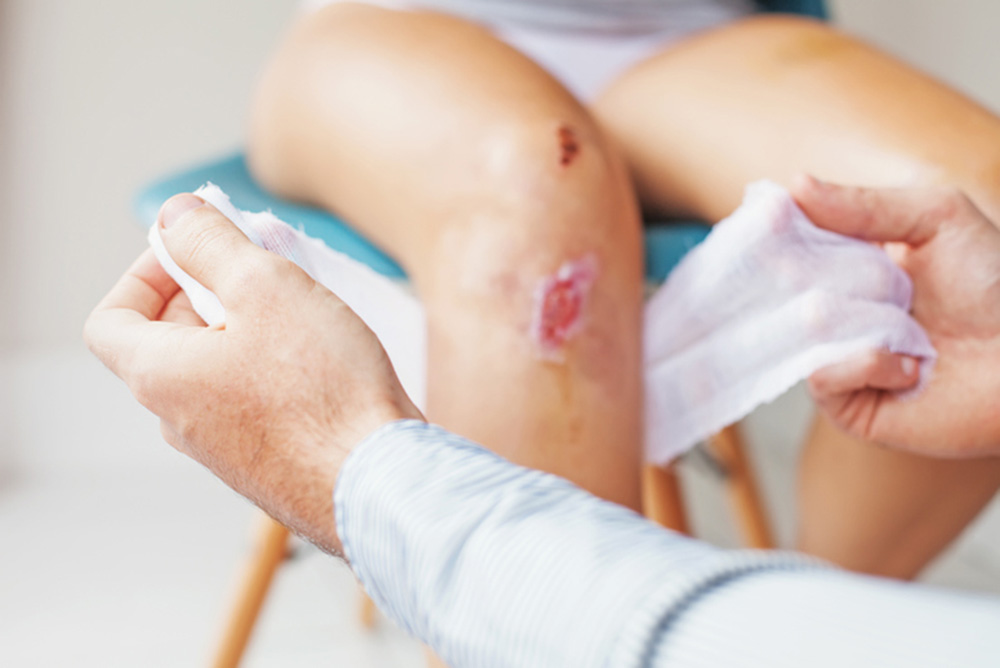
iStock
PHILADELPHIA PAINTER J.C. had a minor cut that never “scabbed over completely” until a dermatologist diagnosed eczema as the underlying reason for delayed healing. Another wound remained open eight weeks after laser surgery to remove a small, potentially cancerous bump on his ankle, despite using mupirocin and a “cohesive” bandage, and staying out of the water as prescribed.
DC writer M.W. had a small cut on the bottom of her foot that wasn’t healing but didn’t hurt, although when she admitted to some loss of feeling in her feet, the doctor reacted quickly with a tetanus booster, prescriptions for Bactrim and mupirocin ointment, and instructions to swim only in salty or chlorinated water—no ponds or lakes.
You have a cut or a burn or a sore—or in rare cases, an injection site—that isn’t healing, and the weeks pass. You started off doing all the right things: cleaning it with soap and running water—not peroxide or iodine because these can irritate the wound and delay healing; applying antibiotic ointment; and covering with a bandage. And to stop bleeding, applying pressure.
For a wound that is large, deep, won’t stop bleeding, or is on your face or over a joint, stitches can help speed healing but must usually be done in the first eight hours after the injury before bacteria has a chance to enter the skin and before the body’s own healing response begins.
Common signs that a wound is becoming infected are the skin becoming redder or more painful, or the sore becoming warm, swollen or oozing. More serious indicators are chills or fever over 100 degrees and red streaks near the wound.
Infections occur more often in people over 60 and more often in men due to their lower estrogen levels. Besides hormones, other factors are reduced immunity, use of many medications, inadequate nutrition and general stress. Non-healing wounds affect between 3 and 6 million people in the U.S.; those 65 and older account for 85% of them.
The most common cause of infection is healthy bacteria living on the skin’s surface—notably staphylococcus, present on the skin of 90% of the population—that enters the body. Even for wounds that start as small cuts, healing can be too slow to keep bacteria out.
Recent cases of infections following intramuscular injections of vitamins, non-steroidal anti-inflammatory drugs and other pain-killers have been traced to staphylococcus, atypical mycobacteria, E. coli and Clostridium species (like C. diff). These are deep-muscle infections that can be notoriously resistant to treatment. Causes are inadequate cleaning of the skin with alcohol prior to an injection; also alcohol doesn’t remove all forms of bacteria.
Atypical bacterial infections are also associated with cosmetic and plastic surgery and also occur more often in older populations, with South Florida identified as a high-risk area.
For slow-healing wounds, the main worry is MRSA, methicillin-resistant Staphylococcus aureus bacteria, which can invade even minor skin problems such as insect bites, but more often arises as painful skin boils and spreads via skin-to-skin contact. In addition, for mupirocin, the antibiotic ointment most often prescribed to protect against MRSA, resistance can develop after about 10 days.
The most dangerous outcome of infection is sepsis, most common in those over age 65 though it can occur at any age. It is often undiagnosed because of general unfamiliarity with the symptoms: chills or fever, extreme pain, clammy or sweaty skin, shortness of breath and a high heart rate. Sepsis develops when the body mounts a response to infection that overwhelms the organs, impedes blood flow and lowers blood pressure. It is the contributing factor in up to half of all hospital deaths.
Chronic wounds—those failing to heal after three months—are more common over age 60 for the same reasons that infections more often afflict older adults. Among nutrition issues, low-carbohydrate diets can include too little vitamin C.
Allergic reactions, such as contact dermatitis, are another cause of delayed wound healing. Set off by topical medications such as antibacterials and antiseptics, it is common with advancing age due simply to more years of exposure to multiple allergens. “Atopic”—meaning allergic —dermatitis such as eczema can increase the likelihood of skin infections; in turn, treating the eczema can also heal the wound.
Slow healing can also be traced to systemic problems, most often diabetes and heart disease; also to peripheral neuropathy, in which impaired functioning of sensory nerves reduces the immune defense mechanisms.
Treatment for non-healing wounds usually includes a broad-spectrum antibiotic such as Bactrim and a topical ointment like mupirocin, as well as an updated tetanus shot. For severe skin lesions, especially among diabetics, a newer option is the allograft – a graft from a non-identical donor — created using placentas donated after women give birth, which is injected or surgically transplanted.
For stubborn non-healing wounds, the general advice includes heat and elevation three to four times a day. The main lesson, though, is to pay attention and don’t hesitate to seek medical attention for suspicious signs and wounds that simply last too long.
—Mary Carpenter
Every Tuesday in this space, well-being editor Mary Carpenter fills us in on health news we can use.
